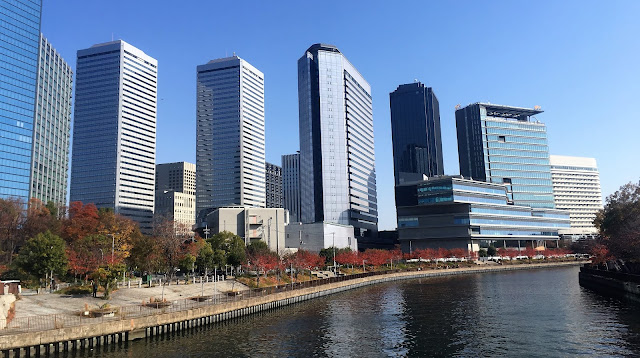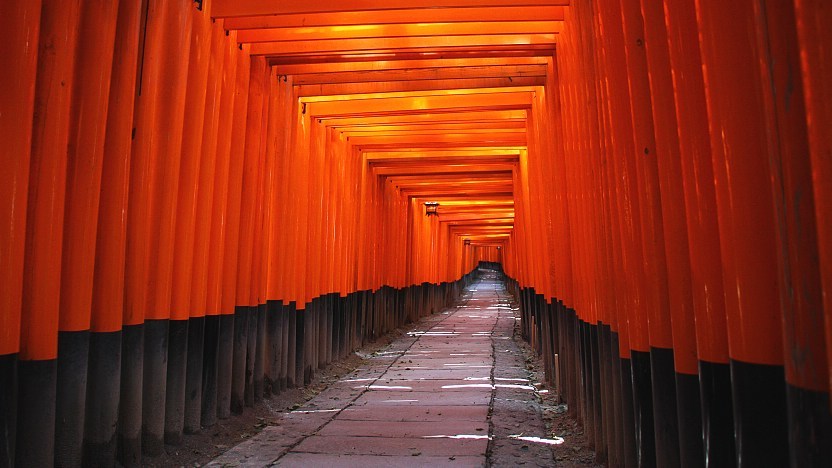Traveling to Japan: Humble Tips to Share
The following tips came from writer who only been to Japan twice (Tokyo and Osaka). Neither of the tips are professionally given advice nor self-claim expert hacks. Throughout writer visits, writer made few mistakes and personally would like to share with reader their experience so that if one were given an opportunity to visit Japan, may one experience calm and smooth journey.
 |
| Osaka Business Park |
Traveling to Japan is a dream everyone hold. But other than be quiet in trains and memorizing simple Japanese, what are other advice that one should note before arriving at their airport? Not that best traveling hacks you've heard, here are just 3 personal tips (from my view) I thought you should pay extra attention to get you a calm journey and get the most out of your trip there.
1. Dress Like Locals
One line tips that could apply to any other country. It doesn't matter what outfit styles you prefer at your home country, when you come to Japan, I genuinely suggest you to dress like locals. Japanese tend to wear natural colour. If you ever watch Japan's documentary or travel vlog of some sort, you'll notice they wear mostly blacks, grey, white, khaki or just light shade of any colour. It might be weird for you to stand out among them with your funky stripes pant.
 |
| My bright red coat has left the chat. |
Japanese will never glare at your bright-red jacket or dark orange palazzo anyway, however you might feel uneasy knowing your colour diffract strong energy as oppose to the locals. By wearing natural colour clothing like them, you also indirectly help to maintain peaceful and pleasing atmosphere in public. Japanese has always been known as the most respectful people towards tourist, hence it will do no harm for us to blend in with them during our visit.
2. Skip Attraction Spot
Tourist visiting Japan for the first time will try to rush to all popular places, to feel what others have felt visiting it. Remain calm and don't rush to cramp all attraction spots just because it's popular. If you plan to go on personal trip rather than on tour guide, skip the attraction spot. You might easily mesmerize with that perfect Instagram shot when you're planning trip but here's my take; don't fall for it. While it is fun to explore popular places, those places are a burden (to tourist) in reality. Especially if you take trains. Why? Because most popular places you've seen are not close to each other. Besides, it's overcrowded and to disappoint you, might over hyped.
Tourist visiting Japan for the first time will try to rush to all popular places, to feel what others have felt visiting it. Remain calm and don't rush to cramp all attraction spots just because it's popular. If you plan to go on personal trip rather than on tour guide, skip the attraction spot. You might easily mesmerize with that perfect Instagram shot when you're planning trip but here's my take; don't fall for it. While it is fun to explore popular places, those places are a burden (to tourist) in reality. Especially if you take trains. Why? Because most popular places you've seen are not close to each other. Besides, it's overcrowded and to disappoint you, might over hyped.
Here's an example; most common spot guide you'll get if you were to visit Osaka is Kobe (Kobe Port Tower, Arima Onsen etc) to Kyoto (Kyoto Tower, Arashiyama Bamboo Forest, Shinkansen etc) to Nara (Deer Park, Fushimi Inari etc). Let's drop Kobe and Kyoto, try focusing on Nara. Even distance between Deer Park and Fushimi Inari takes you longer than expected on trains, what more Arashiyama Bamboo Forest (which most travel guide suggest you to visit after Kyoto Tower).
At Nara Deer Park, you'll get to enjoy feeding deer cookies and explore tastiness of famous mochi a few kilometers from the park. These 2 spots should be enough for one day. What about Fushimi Inari? Just a tour spot popular for its shrine and great Instagram spot! Unless you have a great understanding of shrines' history and architectural, I genuinely advice you to just skip Fushimi Inari, or visit it the next day. The point is to not cramp 3 to 4 tourist spots in one day.
Best Japan trip would be involve riding on their trains and railway. Their country also known for its effective railway and on-time trains; rarely miss schedule despite numerous trains' track overlapping each other and railway companies intersecting. My advice if you were to ride their train, study railway map carefully and ensure you understand which line to take and which tickets can get you to your desired destination. Worry not! Even after a rounded searched, I did get confused with the trains and platform during my second visit.
 |
| Train board to guide passenger which way train is going and all stations' name they cover. (Source: OsakaStation.com) |
What you should do? Find the Station Master, a worker assign to oversee ticket machines. Don't ask locals as most of them didn't know the whole railway stuff either. Approach Station Master instead (they were given the job title for reason) and simply ask your train. Also don't forget to bring railway map (physically or digitally) to make it easier for them to understand your route.
While we at this topic, it's also recommended for you to use concise word for easier communication with Station Master.
DON'T:
1. "Hi there! We are lost here. Can you please tell us which one is the way to Nipponbashi?"
2. "Hello please help us. I thought we're supposed to get on platform number 2 to Namba Station?"
3. "Do we need to buy 2 tickets to Universal-City?"
DO:
1. "Nipponbashi?"
2. "Namba Station?"
3. "Universal-City, 1 ticket or 2 tickets?"
Station Master would be very glad to help you. Reminder, due to expansion of railway to hold increasing influx of passengers, most central stations in Japan are (as of now) a mix of old and new design hence the route inside the station can confuse you a lot. Precisely for underground station, their way to platform can be hidden behind shops or far away than you thought. So ask! Station Master are always available at any station, central or subway station, meanwhile Information Center can be found at central station only.
Be mindful with your planning. It's better to fully grab experience and cherishing moments lively at one spot rather than running here and there but end up feeling nothing. Won't that be a waste of energy?
To end this, I highly recommend you to use trains and railway during your visit. It's the closest atmosphere you can feel and share with the locals. Plus, you'll feel most pleasure getting to your destination on your own rather than tour guide.
Hope my share can be of any help for you. Thank you for your reading.
Mochi mochi!
To end this, I highly recommend you to use trains and railway during your visit. It's the closest atmosphere you can feel and share with the locals. Plus, you'll feel most pleasure getting to your destination on your own rather than tour guide.
Hope my share can be of any help for you. Thank you for your reading.
Mochi mochi!


Comments
Post a Comment